
A mysterious host invites eight guests, each of them a stranger to the others, for an island holiday off the coast of Devon, a pair of married servants in attendance and said host (or hostess?) nowhere to be seen. Does this sound like recipe for murder?
To a diehard Agatha Christie fan, it not only does, it sounds suspiciously like And Then There Were None (aka Ten Little Indians), published first as a novel in 1939 and then adapted for the stage by the author herself in 1943.
Hollywood’s Actors Co-op now revives this Christie gem in a production that makes for as entertaining and suspenseful a mystery thriller as any Christie fan or neophyte could possibly ask for, thanks to incisive direction by Linda Kerns and topnotch performances by an all-around terrific cast.
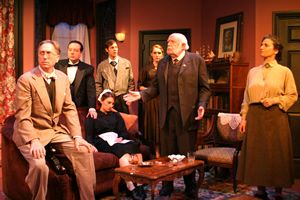 The reason that guests and servants have been assemble by a certain U.N. Owen (a name sounding suspiciously like the word “unknown”) soon becomes clarified by a disembodied (i.e. prerecorded) male voice. Each of them has committed murder, they are told, a murder that could not be proven in a court of law, but a murder nonetheless, and each will soon be receiving a punishment fitting not only the crime, but the nursery rhyme hanging above the mantelpiece. You may have heard it. It starts with, “Ten little soldier boys went out to dine; One choked his little self and then there were nine,” and ends with “One little soldier boy left all alone; He went out and hanged himself and then there were none.”
The reason that guests and servants have been assemble by a certain U.N. Owen (a name sounding suspiciously like the word “unknown”) soon becomes clarified by a disembodied (i.e. prerecorded) male voice. Each of them has committed murder, they are told, a murder that could not be proven in a court of law, but a murder nonetheless, and each will soon be receiving a punishment fitting not only the crime, but the nursery rhyme hanging above the mantelpiece. You may have heard it. It starts with, “Ten little soldier boys went out to dine; One choked his little self and then there were nine,” and ends with “One little soldier boy left all alone; He went out and hanged himself and then there were none.”
When one amongst them does indeed “choke his little self” by drinking a cocktail laced with cyanide, and then a second “oversleeps herself” with an overdose of sleeping pills, and a third meets his Maker through a knock the head (also per the nursery rhyme), it becomes crystal clear that by the time the weekend is over, there may indeed be but one “little soldier” left with no other choice but to do as the rhyme has instructed.
Like any classic Agatha Christie novel or play, And Then There Were None is peopled by a particularly diverse cast of characters, and like any Actors Co-op production, And Then There Were None is peopled by a particularly fine cast of actors.
The victims are, in order of appearance (and not of permanent disappearance):
Fred and Ethel Rogers (Pete Pano and Teresa Bisson), butler and cook accused of killing their former employer; Vera Claythorne (Greyson Chadwick), one-time governess said to have allowed her young charge to drown; Philip Lombard (Clay Bunker), a soldier of fortune who may have caused the deaths of men in his charge; Anthony Marston (Matthew Grondin), a spoiled playboy whose reckless driving could on at least one occasion have proven fatal; William Blore (Jack Kandel), a retired police inspector whose false accusations may have led to a man’s death in prison; General Mackenzie (Don Robb), an elderly gent accused of having sent his wife’s lover to his death; Emily Brent (Deborah Marlowe), a repressed old spinster whose Bible-thumping may have led to a young woman’s untimely demise; Sir Lawrence Wargrave (Steve Gustafson), a retired judge whose penchant for the death penalty may have sent an innocent man to the gallows; and Dr. Armstrong (Wenzel Jones), a Harley Street doctor said to have caused a patient’s death by operating on her while drunk.
The fewer the number of remaining guests, the clearer it becomes that before long only two survivors will be left in the otherwise empty house…and since one of them must perforce be the killer, that number will soon be divided in half. Or will it?
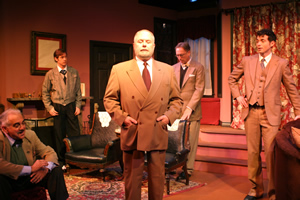 Director Kerns eschews the tongue-in-cheek in favor of the authentic, a decision which ups the suspense and provides ample opportunity for her ensemble to create believable characters who find themselves in an incredible situation. Among cast standouts are Gustaftson’s commanding Sir Lawrence, Kandel’s dynamic Blore, and Jones’s fussy, fidgety Dr. Armstrong. Bunker and Chadwick provide sparkle (and sparks) as two of the accused who find themselves attracted to each other despite the potential danger of falling for a killer. The chameleon-like Marlowe vanishes into the skin of old maid Miss Brent (Elvira Gulch played deadly straight), the venerable Robb provides ample gravitas as General McKenzie, and Bisson, Grondin, Pano, and Sergio Mautone (in the cameo role of boatman Fred Narracott) complete the cast in tiptop fashion.
Director Kerns eschews the tongue-in-cheek in favor of the authentic, a decision which ups the suspense and provides ample opportunity for her ensemble to create believable characters who find themselves in an incredible situation. Among cast standouts are Gustaftson’s commanding Sir Lawrence, Kandel’s dynamic Blore, and Jones’s fussy, fidgety Dr. Armstrong. Bunker and Chadwick provide sparkle (and sparks) as two of the accused who find themselves attracted to each other despite the potential danger of falling for a killer. The chameleon-like Marlowe vanishes into the skin of old maid Miss Brent (Elvira Gulch played deadly straight), the venerable Robb provides ample gravitas as General McKenzie, and Bisson, Grondin, Pano, and Sergio Mautone (in the cameo role of boatman Fred Narracott) complete the cast in tiptop fashion.
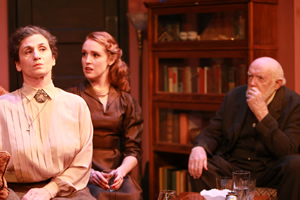 And Then There Were None looks sensational on the David Schall Theatre stage, thanks to scenic and property designer Karen Ipock’s finely detailed living room set, Mark Svastics’ expert lighting design, and Vicki Conrad’s period costumes and Krys Fehervari’s period hair design (both of them in a vague sometime between the 1930s and 1950s). Warren Davis scores high marks for a sound design which not only provides plenty of suspenseful effects but ups the tension with aptly chosen background music. Dialect coach Jill Massie has insured what appear to this reviewer’s ears to be bona fide British accents of the time period, despite an occasional /æ/ in place of the more authentic /ɑ/. Stage manager Rachel Landis deserves special credit for thing that go gone in the dark. Kimi Walker is producer.
And Then There Were None looks sensational on the David Schall Theatre stage, thanks to scenic and property designer Karen Ipock’s finely detailed living room set, Mark Svastics’ expert lighting design, and Vicki Conrad’s period costumes and Krys Fehervari’s period hair design (both of them in a vague sometime between the 1930s and 1950s). Warren Davis scores high marks for a sound design which not only provides plenty of suspenseful effects but ups the tension with aptly chosen background music. Dialect coach Jill Massie has insured what appear to this reviewer’s ears to be bona fide British accents of the time period, despite an occasional /æ/ in place of the more authentic /ɑ/. Stage manager Rachel Landis deserves special credit for thing that go gone in the dark. Kimi Walker is producer.
Agatha Christie buffs who know that the author created an alternate ending for her stage adaptation may be interested in learning that a version preserving her original ending debuted in London in 2005. The Co-op sticks with the ending stage and screen aficionados are familiar with, one which provides no less of a surprise for those experiencing this suspense tale for the first time. Whether you’re a Christie aficionado or new to the Queen Of Crime, Actors Co-op’s spiffy revival guarantees you a murderously good time.
Actors Co-op, 1760 N. Gower St., Hollywood.
www.actorsco-op.org
–Steven Stanley
November 4, 2012
Photos: Lindsay Schnebly

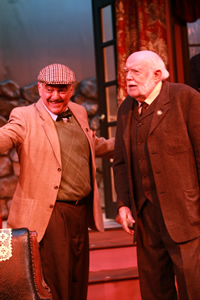
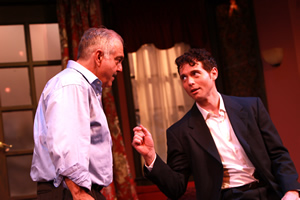

 Since 2007, Steven Stanley's StageSceneLA.com has spotlighted the best in Southern California theater via reviews, interviews, and its annual StageSceneLA Scenies.
Since 2007, Steven Stanley's StageSceneLA.com has spotlighted the best in Southern California theater via reviews, interviews, and its annual StageSceneLA Scenies.







 COPYRIGHT 2024 STEVEN STANLEY :: DESIGN BY
COPYRIGHT 2024 STEVEN STANLEY :: DESIGN BY